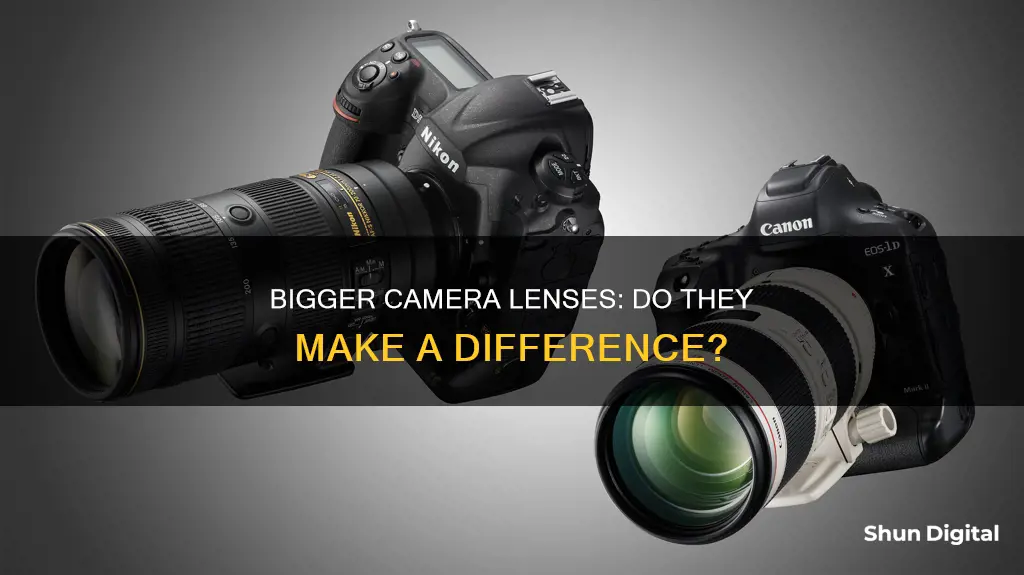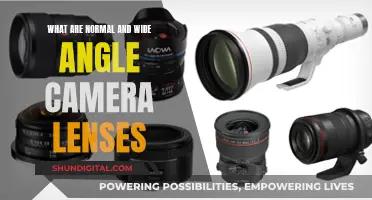
The diameter of a camera lens is a crucial factor in photography, as it directly influences the amount of light that reaches the sensor and, consequently, the image quality. A larger lens diameter allows for a wider opening, increasing the brightness and enhancing the focus of the final image. Conversely, a smaller lens diameter reduces the light that enters the camera, resulting in a dimmer picture.
However, it is essential to understand that the lens diameter is not the sole determinant of image quality. Other factors, such as the lens design, focal length, aperture, and maximum aperture, also play significant roles in achieving stellar photographs.
When comparing lenses of different focal lengths, the diameter might not be a meaningful indicator, and it is more informative to consider their f-numbers instead. Additionally, the type of lens (prime vs. zoom) and physical quality (consumer vs. premium) are factors that can outweigh the impact of lens diameter on image quality.
| Characteristics | Values |
|---|---|
| Camera lens diameter | The measurement of the very front part of the lens |
| Importance | More important than the camera itself |
| Larger camera lens diameter | Lets in more light |
| Smaller camera lens diameter | Produces a dimmer picture |
| Aperture | The opening size that lets in the light for a fixed image |
| Focal length | The distance between the recording of the image and the point of lens convergence |
What You'll Learn

Larger camera lenses let in more light
A larger camera lens diameter lets in more light, which affects image quality. The bigger the lens diameter, the wider the opening, increasing brightness and sharpening the focus. A smaller camera lens, therefore, produces a dimmer picture.
The diameter of a lens is the physical distance from one side of the front of the lens to the other, measured in millimetres. The lens diameter will be preceded by the symbol of an o with a slash and followed by the diameter size.
The f-number (or f-stop) is related to the lens aperture diameter by the following formula:
> f/ = focal length/aperture diameter
So, if you have two lenses of the same focal length and one has a larger lens diameter than the other, the one with the larger diameter will have a smaller maximum f-number, letting in more light.
However, if you are comparing two lenses of different focal lengths, the different diameters don't necessarily mean anything, and you need to look at the f-numbers instead.
Lens and Camera Compatibility: Are Lenses Camera-Specific?
You may want to see also

A wider opening increases brightness
A wider opening on a camera lens increases the brightness of an image by allowing more light to enter the lens. This is because the brightness of an image is directly influenced by the amount of light that passes through the lens and reaches the sensor.
The opening of a camera lens is known as the aperture, and it can be adjusted to control the amount of light that enters the lens. This adjustment is measured in f-stops, where a smaller f-stop number indicates a wider aperture. For example, an aperture of f/1.8 is wider than an aperture of f/2.8.
The maximum aperture, or the widest possible opening of a lens, is particularly important when taking pictures in low-light conditions, such as at night. Lenses with wider maximum apertures are better suited for these situations as they allow more light to reach the sensor, resulting in brighter images.
It is worth noting that while a wider aperture increases the overall brightness of an image, it also affects the depth of field. A wider aperture results in a shallower depth of field, which can make it more challenging to achieve accurate focus, especially in low-light conditions.
In addition to the aperture, other factors also influence the brightness of an image. These include the focal length of the lens, the lighting conditions, and the use of filters or other accessories. However, the aperture plays a crucial role in determining the final brightness and visual quality of the image.
Camera Lenses: Reselling and Buying Used
You may want to see also

Larger lenses sharpen the focus
The camera lens diameter is the measurement of the very front part of the lens. It is one of the most important factors to consider when taking a picture. The bigger the lens diameter, the more light it lets in. This increase in light-collecting power means that the lens elements can be used internally to produce higher picture resolution and image brightness.
A larger lens diameter allows for a wider opening, which increases brightness and sharpens the focus. Conversely, reducing the lens diameter reduces the light that strikes the lens, creating a dimmer image.
The aperture is the opening size that lets in light for a fixed image. The smaller the aperture, the more light enters; the larger the aperture, the less light enters. A wide maximum aperture is ideal for taking pictures at night when the light is low.
The focal length refers to the distance in millimetres between the recording of the image and the point of lens convergence. The smaller the number of millimetres, the larger the field of view. The larger the number of millimetres, the smaller the field of view.
The camera lens is the most crucial element in taking a stellar picture. The lens size always affects the image quality.
Other factors to consider
While the camera lens design is complex, the diameter is not the only factor to consider when taking a great photo. The aperture, maximum aperture, and focal length are also important.
The aperture and focal length work together with the lens diameter to create the final image.
Lenses Unlocked: Capturing Unique Perspectives and Effects
You may want to see also

Smaller lenses produce dimmer pictures
A camera lens is the most crucial element in taking a stellar picture. The lens diameter, or the measurement of the very front part of the lens, is one of the most important factors to consider when taking photographs.
A larger lens diameter allows for a wider opening, which increases brightness and sharpens the focus. This is because a larger lens lets in more light, increasing its light-collecting power. This means that the lens elements can be used internally to produce higher picture resolution and image brightness.
On the other hand, a smaller camera lens produces a dimmer picture. This is because reducing the lens diameter reduces the light that strikes the lens. Therefore, the lens size always affects the image quality.
Camera Lenses: Waterproof or Not?
You may want to see also

Larger lenses have a smaller maximum f-number
A larger lens diameter allows for a wider opening, which increases the brightness and sharpens the focus of an image. The f-number, or f-stop, is the ratio of the lens focal length to the diameter of the entrance pupil. A lower f-number means a larger relative aperture and more light entering the system, while a higher f-number means a smaller relative aperture and less light entering the system.
A larger lens will have a lower f-number, meaning it can have a larger aperture. A larger aperture allows more light to enter the camera, resulting in a brighter photograph. A larger lens with a lower f-number will, therefore, be able to produce a brighter image than a smaller lens with a higher f-number.
For example, a lens with an f-number of f/2 will have a larger aperture and let in twice as much light as a lens with an f-number of f/4. This is why a larger lens diameter matters; it directly affects the image quality by allowing for a wider aperture and more light to enter the camera.
To summarise, a larger lens diameter results in a lower f-number, which allows for a larger aperture and more light to enter the camera, leading to a brighter and sharper image.
Polarized Camera Lenses: Worth the Investment?
You may want to see also
Frequently asked questions
Yes, larger camera lenses matter as they let in more light, which increases the brightness and sharpens the focus of the image.
The camera lens is the most crucial element in taking a stellar picture. The lens focuses the light onto the back of the camera, and without it, all you would see is a white light on the image.
The camera lens diameter is the measurement of the very front part of the lens. The aperture is the opening size that lets in the light for a fixed image. The smaller the aperture, the more light enters, and the larger the aperture, the less light enters.
There are five types of camera lenses, each performing a different function: standard, telephoto, macro, wide-angle, and three other specialty lenses (fisheye, tilt-shift, and infrared).
In addition to the lens diameter, other factors such as focal length, maximum aperture, and field depth are important to consider when choosing a camera lens.







